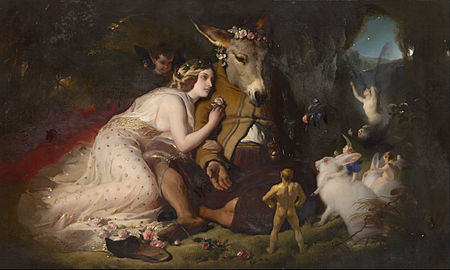Titania (A Midsummer Night's Dream)

Titania is a character in William Shakespeare's play A Midsummer Night's Dream. In the play, she is the queen of the fairies. Due to Shakespeare's influence, later fiction has often used the name "Titania" for fairy queen characters.
In traditional folklore, the fairy queen has no name. Shakespeare took the name "Titania" from Ovid's Metamorphoses, where it is an appellation given to the daughters of Titans.[1]
Shakespeare's Titania is a very proud creature and as much of a force to contend with as her husband Oberon. She and Oberon are engaged in a marital quarrel over which of them should have the keeping of an Indian changeling boy. This quarrel is the engine that drives the mix ups and confusion of the other characters in the play. Due to an enchantment cast by Oberon's servant Puck, Titania magically falls in love with a "rude mechanical" (a labourer), Nick Bottom the weaver, has been given the head of a donkey by Puck, who feels it is better suited to his character. It has been argued that this incident is an inversion of the Circe story.[2] In this case the tables are turned on the character, and rather than the sorceress turning her lovers into animals, she is made to love a donkey after Bottom has been transformed.
Other references


Titania has appeared in many other paintings, poems, plays and other works.
- In Edmund Spenser's Faerie Queene, the title character is a descendent of Titania.
- Johann Wolfgang von Goethe included the figures from Shakespeare's work in Faust I, where she and her husband are celebrating their golden wedding anniversary.
- Alfred Lord Tennyson's play The Foresters, which is a Robin Hood story, has a brief segment with Titania, Queen of the Fairies.
- Titania, one of Uranus's moons, was also named after her.
- Titania appears in the popular online game Warframe as the namesake of one of the suits, featuring razor-butterflies and assorted fairy-themed abilities.[5]
- Titania, Queen of the Fairies, is the nickname given to Erza Scarlet in the anime Fairy Tail.[citation needed]
- In Jim Butcher's book series The Dresden Files Queen Titania, the Fairy Queen of The Summer Court, is a recurring character who holds a deep hatred for Harry Dresden.[citation needed]
References
- ^ Holland, Peter, ed. A Midsummer Night's Dream (OUP, 1994)
- ^ Paul A. Olson, Beyond a Common Joy: An Introduction to Shakespearean Comedy, University of Nebraska 2008, pp 79-82
- ^ "Description of " The Song of Los, copy B, object 5 (Bentley 5, Erdman 5, Keynes 5)"". William Blake Archive. Retrieved January 27, 2013.
{{cite web}}: Unknown parameter|editors=ignored (|editor=suggested) (help) - ^ "The Song of Los, copy B, object 5 (Bentley 5, Erdman 5, Keynes 5)". William Blake Archive. Retrieved January 27, 2013.
{{cite web}}: Unknown parameter|editors=ignored (|editor=suggested) (help) - ^ "Warframe Titania". warframe.com. Digital Extremes. Retrieved 1 December 2016.
